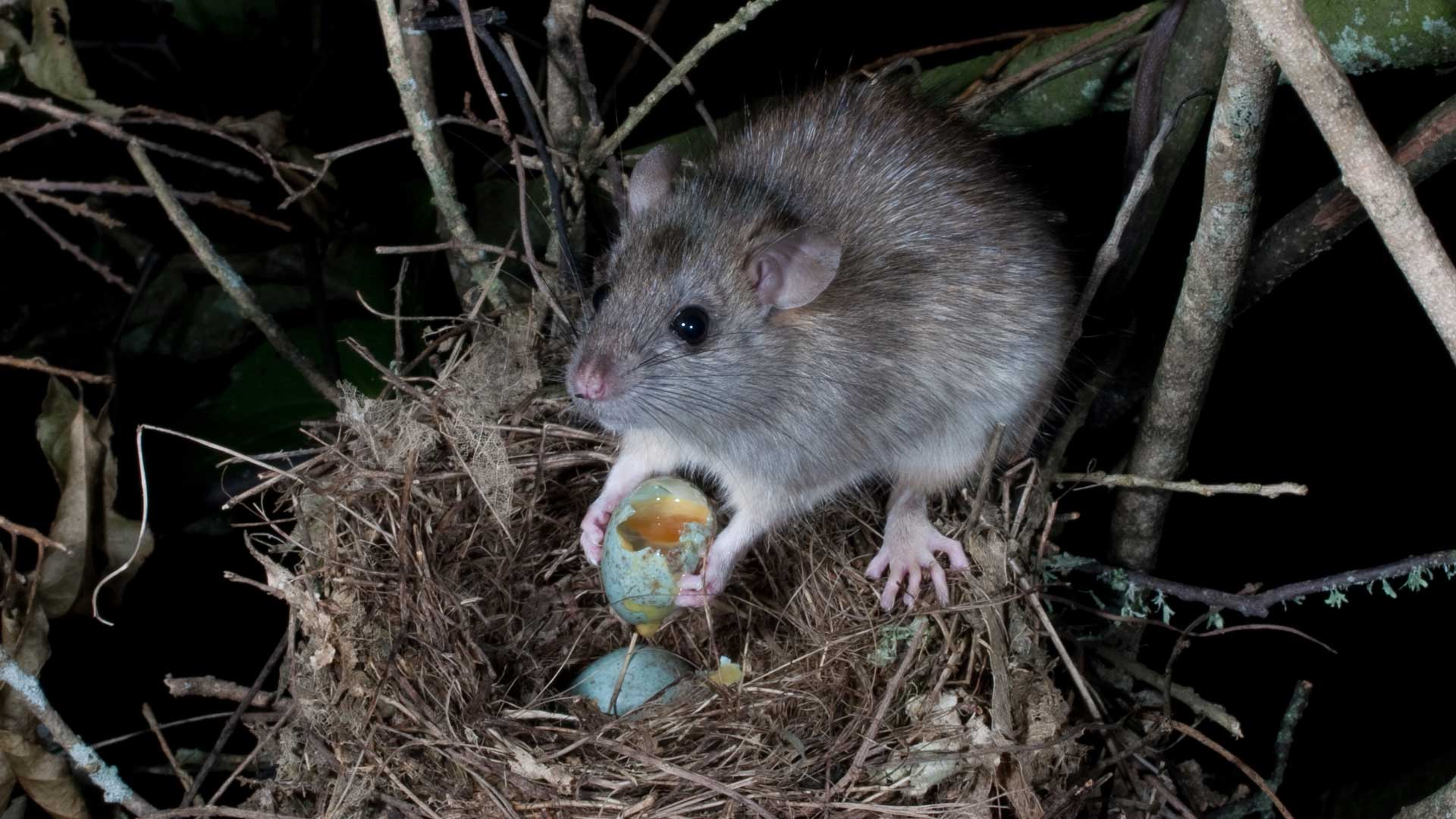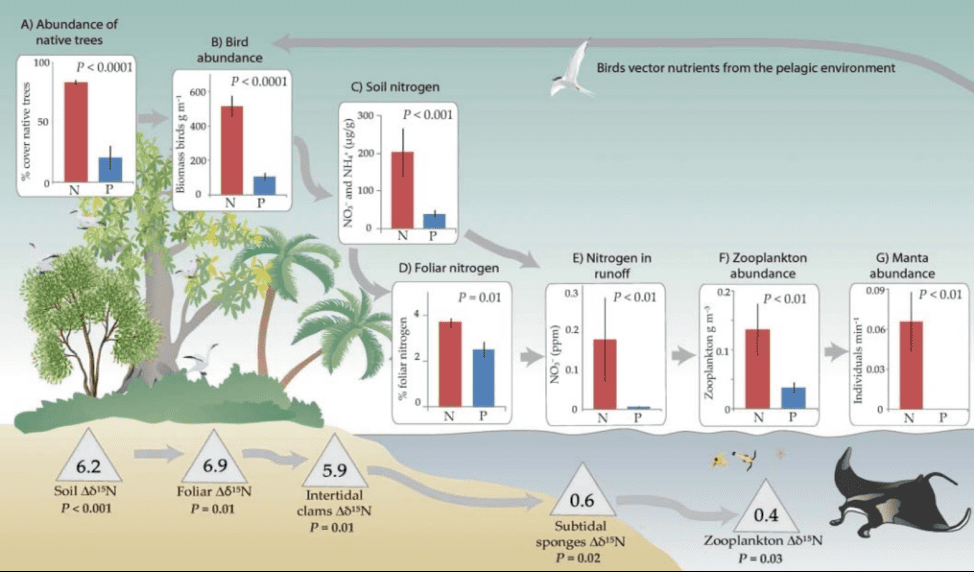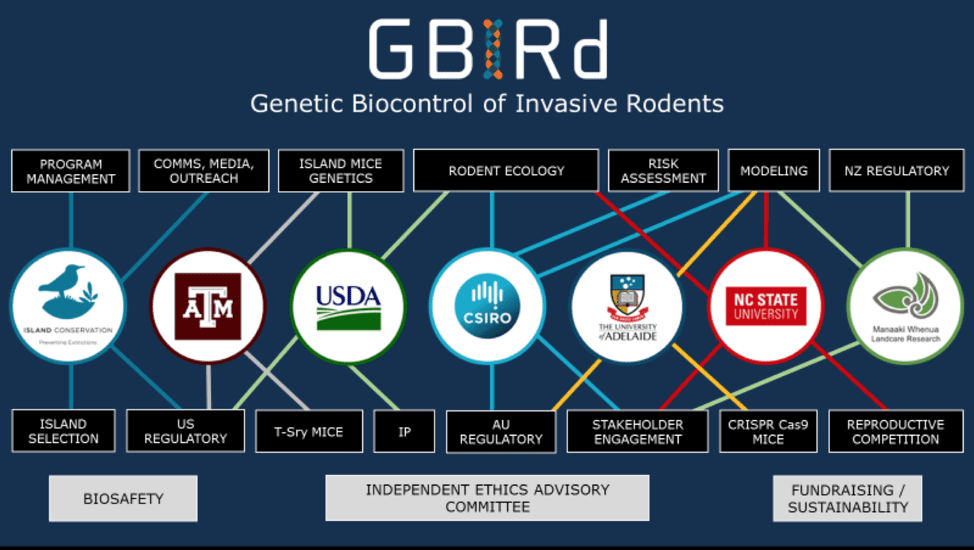Marine Threat: Islands & Marine Biodiversity
BACKGROUND
Invasive rodents on islands are one of the greatest threats facing global seabird bird populations. Recent research shows these rodents are altering near-shore marine environments through a cascading effect that links seabird guano to ocean health. In aggregate, this is a significant problem for the ocean because there are more than 400,000 oceanic islands across the globe that are critical for marine ecosystems and at-risk seabird populations.
Two studies show the ecologic link between invasive rodents and healthy oceans.
In 2012, McCauley showed that when seabirds in the Palmyra Atoll roost on native trees and produce guano that fertilize soils, the resulting increase in coastal nutrients increases the abundance of plankton and subsequently manta rays along island coastlines that eat this primary food source.
Figure 1 below illustrates the difference between the two ecological states – one with higher and one with lower seabird populations, which produce more or less nutrient-rich guano, respectively. Bar graphs comparing processes in native (N) and palm (P) forests, indicate that reductions in native tree abundance (A) reduce seabird abundance (B), which diminish the contribution of seabird-derived nutrient subsidies to terrestrial ecosystems (C,D), which severely impair the movement of nutrients to the marine environment (E), reducing zooplankton abundance (F), and ultimately eliminating manta ray (Manta birostris) utilization of native forest coastlines (G).
A study conducted by Graham et al. (2018) showed that invasive rodents can drive this reduction in seabird populations and nutrient-rich guano. The rodents prey on adult seabirds, their eggs, and chicks. They also eat seeds and saplings that create the trees the birds need for roosting and nesting. As a result, “seabird densities and nitrogen deposition rates are 760 and 251 times higher, respectively, on islands where humans have not introduced rats,” writes Graham et al. Fish biomass was 50 percent greater around the rat-free islands than the rat-infested islands. The paper concluded that “rat eradication on oceanic islands should be a high conservation priority as it is likely to benefit terrestrial ecosystems and enhance the functioning and productivity of coral reefs by restoring seabird-derived nutrient subsidies from large areas of ocean.”
PROGRESS TO DATE
There have been more than a thousand successful island invasive species eradications worldwide, benefiting thousands of threatened island ecosystems and species (Simberloff et al. 2018). Overall, the success rate for island rat eradications has been 84 percent, according to a study of 617 eradication events (Simberloff et al. 2018). Improvement in techniques has made it possible to remove rodents from larger territories. The removal of rats from 30,000 hectares on South Georgia Island near Antarctica represents the largest rat eradication to date (Simberloff et al. 2018).
Currently, the best method for rodent eradication is rodenticides, which kill existing residents. The first, non-trivial, step is to obtain both government and public approval for using toxicants on the landscape. Restorationists must plan to capture and care for existing domestic and wild species that could be vulnerable during the application of the rodenticide. To be effective, rodenticide must penetrate every rodent territory. In some cases, aerial distribution via helicopter is the most effective way to achieve widespread application.
The most effective toxins used today are anticoagulants that block the vitamin K cycle, causing an inability to produce essential blood-clotting factors (Broome et al., 2014). The rapid effect of anticoagulants is the main advantage over other toxins so that the rodents do not identify the poison as a dangerous food source. After the death of the rodents, workers return wild and domestic animals to the environment.
Rodent eradication is highly effective. Despite seeming expensive and time consuming, eradications turn long-term conservation expenses into a single campaign and end up being a much more ecologically sustainable solution than ongoing management of invasive species. For instance, rat eradication on South Georgia Island cost more than $13 million and the planning and implementation took nearly a decade. Poison bait was distributed by helicopter in three separate trips during three summers from 2010 to 2015. However, when compared to the chronic expense of mitigating the threat to seabirds from rats every year, the eradication was a notable success (Island Conservation pers. comm.).
Despite significant advances in the use of toxicants over recent decades, in many situations these eradication methods are extremely challenging or unfeasible. Challenges include islands with significant human populations, stakeholder communities adverse to the use of biocides, potential off-target harm to livestock and domestic animals, or potential negative impacts on native species (Campbell et al. 2015; IUCN Synbio Assessment).
Invasive rodents have been introduced to 80 percent of the world’s island groups. That means a large number of the world’s 400,000 islands are still struggling with invasive species today. The scale and scope of this problem far exceeds eradication efforts to date. To match the solution to the problem, new tools that are more effective, efficient, less toxic, and lower risk are essential.
INNOVATION
Invasive species removal is one of the most feasible and powerful conservation interventions available today for protecting island ecosystems above and below water. Removing invasive species is like pressing an island ecosystem’s reset button: native animal populations rebound and plants flourish, often with little additional intervention. New species sometimes colonize the islands, and species feared to have gone extinct reemerge in the absence of invasive predators.
Genetic tools are some of the most promising potential tools to increase the scale, scope, and pace of eradications on islands. The Genetic Biocontrol of Invasive Rodents (GBIRd) program is a partnership of geneticists, biologists, social scientists, ethicists, and conservationists from research universities, government agencies, and other not-for-profit organizations. Its mission is to investigate the feasibility and suitability of using gene drives or other genetic tools to save island species by efficiently eliminating invasive species.
RNAi
Gene-silencing, or RNA interference (RNAi), uses a double-stranded RNA to block or destroy messenger RNA, thus blocking transcription. While technical challenges remain, successful eradications of agricultural insect pests and rodents using RNAi suggests the technique could be applied in wildlife settings with a high likelihood of success (Campbell et al. 2015). RNAi has also showed promise in other areas: the technology can help with problematic fungal pathogens; pilot projects on two beetle agricultural pests in enclosed settings have succeeded (Baum et al. 2007; San Miguel and Scott 2016); and the U.S. Environmental Protection Agency registered four genetically modified plants that produce RNAi against corn rootworm (EPA 2017).
Because the technique targets specific genes, gene silencing through RNAi promises to be far more effective than either biocides or heritable genetic technologies. Some research even suggests that RNAi could be engineered to differentiate between introduced and native genotypes.
Gene Drive
Gene drives are found in the genomes of many species and can override typical Mendelian inheritance. Gene drives bias inheritance of a particular gene to make it a dominant feature in a population. Scientists are learning how to capitalize on this by hitching specific genes to an engineered gene drive system to bias gene inheritance. In applications focused on eradication, scientists use gene drive to distribute fitness-reducing genes throughout a population to drive it to local extinction. Specifically, a self-limiting gene drive could distort the sex ratio to all male or all female, for example (Webber, Raghu and Edwards, 2015). In such cases, the drive mechanism employed would need to be strong enough to overcome any selective disadvantage incurred by the individuals carrying the genetic manipulation for it to spread. The potential benefits of this approach include species specificity, reduced toxicant use, more humane (non-lethal) approaches, and expanded application on human inhabited islands (Campbell et al., 2015). This represents a potentially transformative advance for the island restoration field not readily achievable with current technology (International Union for the Conservation of Nature, Task Force on Synthetic Biology and Biodiversity Conservation 2018).
The project is beginning work with the house mouse (Mus musculus) because it is one of the most studied and understood mammalian genomes, and because a natural gene drive exists in the house mouse. However, any progress in the development of gene drives that control population levels in mice will lead directly to applications for invasive rat species, and other problematic invasive mammals frequently found on islands.
Obstacles related to social and regulatory acceptability are potentially more significant than technical factors, and these three components are prerequisites for any potential field trial or future release. Social acceptability will be strongly influenced by public perceptions of the need for action, potential efficacy of the technology, potential benefits and adverse effects, and how these relate to socio-economic and cultural factors. Regulatory acceptability will depend upon the specific country, state, local regulations, and case-by-case assessments (International Union for the Conservation of Nature, Task Force on Synthetic Biology and Biodiversity Conservation 2018).
RISKS & CHALLENGES
Socio-economic and Cultural Considerations
Although the situation will differ depending on jurisdiction, some potential areas of impact on socio-economic and cultural considerations for rodent eradication using synthetic biology approaches can be identified:
- Perception of probable efficacy of the method.
- Acceptability of genetic modification as interpreted by cultures and belief systems at a particular site.
- Perceptions of, and likely positive and negative impacts to natural resources and culturally significant species.
- Perceptions of, and potential positive and negative impacts to income generating activities such as tourism, farming, agriculture, and exports
- Potential human health benefits due to the reduction of rodents that could vector diseases (Morand, Jittapalapong and Kosoy, 2015).
- The socio-economic and cultural effects of accidental transfer to non-target populations. (IUCN Synbio Assessment).
Technical Considerations
To date, the genetic constructs for gene drive for use in mammals have proven elusive. There have also been biological concerns raised concerning the ability of an organism to evolve “around” a gene drive that biases sex selection.
LEADERS
The GBIRd program represent the leaders of research and conversation about invasive rodent eradications and includes: Island Conservation, Texas A&M University, USDA, CSIRO, University of Adelaide, University of North Carolina, and Landcare Research (Figure 2). Many organizations have experts working toward the goals of rodent eradication technology development. Many organizations have missions dedicated to preserving biodiversity. GBIRd brings together organizations with both of these missions in an interdisciplinary manner to developing best practices technology and consider societal implications.
FIGURE 2 — Gbird partner organizations.
REFERENCES
Baum, James A., et al. “Control of coleopteran insect pests through RNA interference.” Nature biotechnology 25.11 (2007): 1322.
Campbell, Karl J., et al. “The next generation of rodent eradications: innovative technologies and tools to improve species specificity and increase their feasibility on islands.” Biological Conservation 185 (2015): 47-58.
Graham, Nicholas AJ, et al. “Seabirds enhance coral reef productivity and functioning in the absence of invasive rats.” Nature 559.7713 (2018): 250.
McCauley, Douglas J., et al. “From wing to wing: the persistence of long ecological interaction chains in less-disturbed ecosystems.” Scientific reports 2 (2012): 409.
Morand, Serge, Sathaporn Jittapalapong, and Michael Kosoy. “Rodents as hosts of infectious diseases: Biological and ecological characteristics.” (2015): 1-2.
San Miguel, Keri, and Jeffrey G. Scott. “The next generation of insecticides: dsRNA is stable as a foliar‐applied insecticide.” Pest management science 72.4 (2016): 801-809.
Simberloff, Daniel, et al. “Yes we can! Exciting progress and prospects for controlling invasives on islands and beyond.” Western North American Naturalist 78.4 (2018): 50.
van den Brink, Nico W., et al. “Anticoagulant rodenticides and wildlife: introduction.” Anticoagulant Rodenticides and Wildlife. Springer, Cham, 2018. 1-9.
Webber, Bruce L., S. Raghu, and Owain R. Edwards. “Opinion: is CRISPR-based gene drive a biocontrol silver bullet or global conservation threat?.“ Proceedings of the National Academy of Sciences 112.34 (2015): 10565-10567.







Back to Top